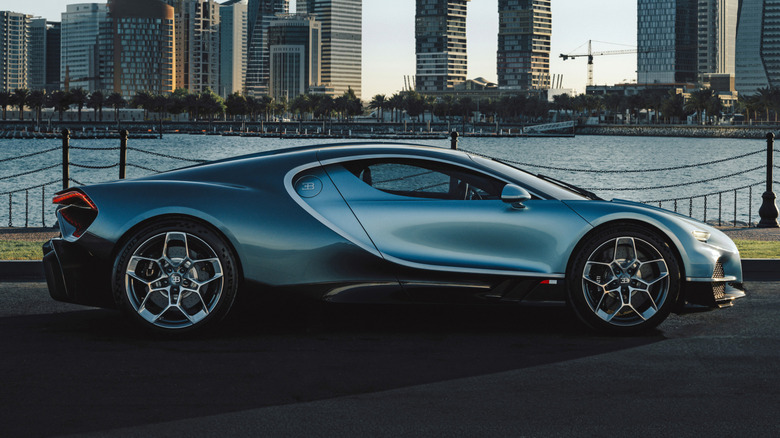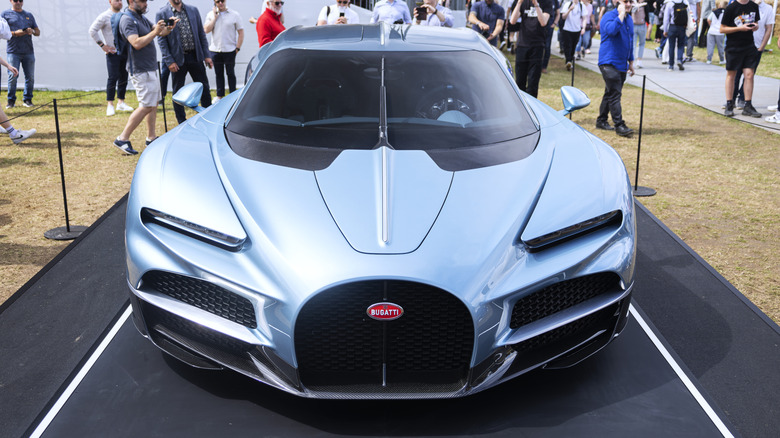Where Are Bugatti's Cars Made, And Who Owns The Company Today?
Few carmakers today embody the same level of opulence as Bugatti. Founded by Ettore Bugatti back in 1909 in Molsheim, France, the automaker has been in the business of making some of the fastest cars on record. What's even more impressive is how Bugatti blends human craftsmanship, exclusivity, and engineering wizardry into rolling works of art that helped coin the "hypercar" term.
At the tail end of 2021, the company's ownership structure underwent a major shift with the formation of Bugatti Rimac, a joint venture that merged the French legacy brand with the Croatian EV company Rimac Automobili. This means that Bugatti Rimac now operates from two key facilities: Molsheim, France, and Zagreb, Croatia.
Even though the final assembly of all Bugatti vehicles continues in Molsheim, parts of the development and future powertrain production will be handled at Rimac's state-of-the-art "Rimac Campus" facility on the outskirts of Zagreb. The campus also operates as the company's global headquarters under new CEO Mate Rimac, and serves as the operational backbone for all Bugatti Rimac products yet to come.
A new era of Bugatti
The first car jointly developed by Bugatti and Rimac is the new hyper-hybrid Bugatti Tourbillon. Bugatti managed to retain the naturally aspirated V16 engine thanks to hybridization, which allowed the automaker to balance electric power with the emotion of a large displacement engine. Summed up by CEO Mate Rimac, "The electric powertrain, being very high tech, very high performance, is actually enabling this very emotional combustion engine, and they complement each other."
The new Tourbillon is estimated to cost around $4.3 million and is expected to start production in 2026 with only 250 examples ever to be made. With a naturally aspirated 16-cylinder engine and three electric motors, the Tourbillon outputs a total of 1,775 horsepower. That makes it the most powerful Bugatti ever made.
However, in stark contrast to most of the car industry these days, this Bugatti does not use any digital screens in its gauge cluster. "We're trapped in the technology of our time," Bugatti Rimac director of design Frank Heyl told Car and Driver. The answer, he said, was to "give the entire interior an analog way that you can interact with it." It represents a daring choice for a daring car, and is just one of multiple ridiculous features of the new Bugatti Tourbillon. This very philosophy defines what new Bugatti models strive to achieve: Creating timeless machines, even if it means embracing analog tech in an increasingly digital world.
The Croatian startup that took Bugatti
Back in 2011, a young BMW enthusiast named Mate Rimac had the engine in his BMW E30 blow up, prompting him to swap it for an electric powertrain. Behind the wheel of this "e-M3," the then-19-year-old broke five Guinness World Records, a feat that later proved invaluable when he founded the EV startup Rimac Automobili.
The first car the company introduced was the impressive, yet relatively unknown Rimac Concept One. This changed when it was involved in a high-profile accident with Richard Hammond, one of the three famous presenters at "Top Gear." While the incident brought global attention to Rimac, it wasn't the kind of publicity the company had hoped for. The positive recognition Rimac had been striving for came later with the launch of the Rimac Nevera, which catapulted the company to the forefront of the EV industry.
Given that Bugatti was always very fond of the idea of breaking records, it seems only fitting that Rimac — the Nevera R just broke another EV speed record — would become its partner. In many ways, Rimac was destined to carry Bugatti's torch. This is not only because this joint venture honors the tradition and legacy that defined Bugatti, but also gives Bugatti the ability to evolve while staying true to its roots.


